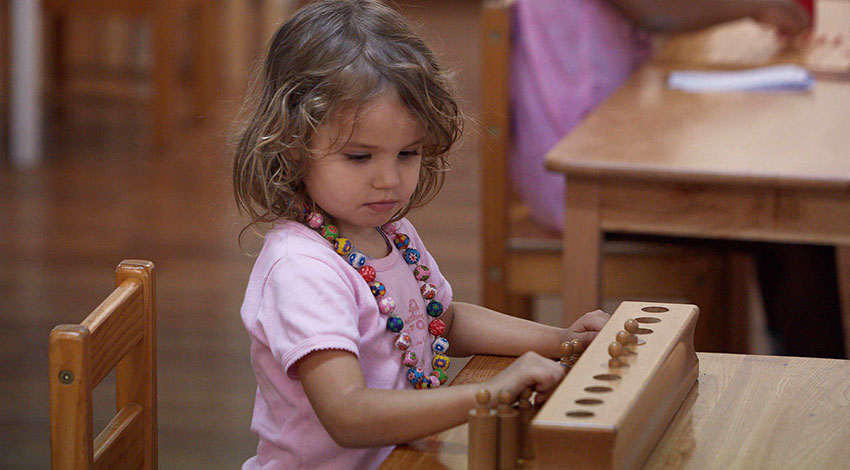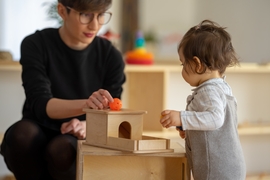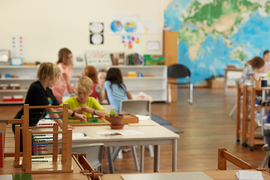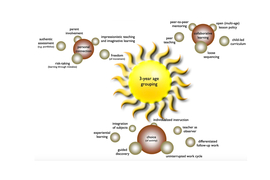
In recent years there has been much debate about the integration of digital technologies, specifically the use of computers, in early childhood settings. In the view of Montessori educators the disadvantages of computer use in early childhood settings outweigh the advantages. For this reason, computers are generally not found in Montessori early childhood settings for children under six years of age.
In the Montessori view young children learn best through multisensory, concrete experience. This is especially true of children from birth to three years of age, but remains significant for children aged from three to six. During the years from three to six children’s development continues to depend on physical movement. Increasingly, children become interested in manipulating real objects to achieve meaningful goals in the concrete and social world around them. During activity of this type, as children learn to regulate and refine the movement of their hands, they are also learning to regulate their mental attention, and thus, their powers of concentration. In addition, purposeful activity that involves manipulating real objects enables children to refine their powers of perception and discrimination using all their senses. During these years children also need to interact with people who are physically present in order to develop the ability to build personal relationships and culturally appropriate behaviour.
When children sit in front of a computer screen, they are not using all their muscles, either large or small. In addition, much of the regulation of the activity is driven by the computer software rather than the children themselves. The range of perceptual and intellectual discrimination and judgement demanded of children is reduced during screen-based activity. Furthermore, children are less likely to interact meaningfully with the people around them because the goals they can achieve with screen-based computer software are less grounded in daily family and community life. In Montessori early childhood settings screen-based activity has the potential to displace children’s work with the Montessori materials.
The Montessori approach to the use of screens in early childhood settings is supported by the Healthy Eating and Physical Activity Guidelines for Early Childhood Settings (Department of Health and Ageing 2009). In these guidelines screen-time is defined as inactive ‘non-productive sedentary behaviour’, which over long periods is associated with:
- less active, outdoor and creative play time
- an increased risk of being overweight
- sub-optimal muscle and bone growth
- unhealthy eating habits
- poorer social skills
- fewer opportunities to develop decision-making, self-awareness and self-regulation skills
- slower development of language skills and short-term memory
- television-viewing habits that continue through childhood. (Department of Health and Ageing 2009: 71-3).
For this reason, the guidelines argue for limiting, or even excluding, screen-time from early childhood settings.
Montessori educators recognise that there are children who may not have access to digital technologies at home and that this raises questions of equity. Nevertheless, in the Montessori view, the knowledge and skills children develop through work with the Montessori materials prepares them very effectively for later use of digital technologies. Experience in Montessori schools has demonstrated that children who have made the transition from the Three to Six Years environment setting to the next stage of schooling, even if they have not had computer access at home, are able to use computers with ease and success at later stages of schooling. This may be because the skills developed in the Three to Six Years environment, especially in the exercises of practical life and the exercises of the senses, indirectly prepare children for successful computer use. These skills include:
- fine motor control and coordination that prepare children to use a mouse and a keyboard
- the ability to sequence and to observe
- the ability to manage abstract concepts
- higher order thinking and problem-solving skills
- procedural thinking.
These skills become a resource children apply when they later work with digital technologies. Furthermore, successful engagement with digital technologies demands the ability to be multiliterate, in other words, to be literate in ‘multimodal ways of communicating through linguistics, visual, auditory, gestural and spatial forms’ requiring ‘the knowledge and skills needed to read, write and use spoken and written language and sounds and images’ (Hill 2007: 56). Montessori educators would argue that the diverse multimodal resources and activities in Montessori early childhood settings equip children par excellence with the knowledge and skills that will set them up for success in a world in which digital technologies and multiple forms of literacy play an important role.
Digital technology is, however, a resource used by the adults in Montessori early childhood settings. For example, pictures and information accessed via the Internet are regularly used to prepare and customise resources to meet the specific learning needs of individual children. Digital cameras are also used to record and document children’s progress, as well as excursions or other special events. Teachers also use digital technologies to keep records and to communicate with families and colleagues.



